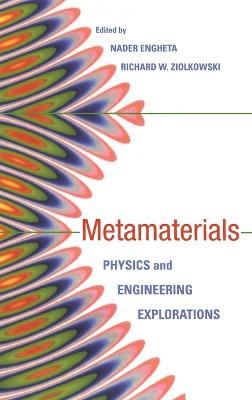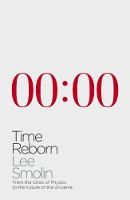Metamaterials
 -15%
portes grátis
-15%
portes grátis
Metamaterials
Physics and Engineering Explorations
Engheta, Nader; Ziolkowski, Richard W.
John Wiley & Sons Inc
08/2006
440
Dura
Inglês
9780471761020
15 a 20 dias
686
Descrição não disponível.
Preface. Contributors.
PART I: DOUBLE-NEGATIVE (DNG) METAMATERIALS.
SECTION I: THREE-DIMENSIONAL VOLUMETRIC DNG METAMATERIALS.
CHAPTER 1: INTRODUCTION, HISTORY, AND SELECTED TOPICS IN FUNDAMENTAL THEORIES OF METAMATERIALS (Richard W. Ziolkowski and Nader Engheta).
1.1 Introduction.
1.2 Wave Parameters in DNG Media.
1.3 FDTD Simulations of DNG Media.
1.4 Causality in DNG Media.
1.5 Scattering from a DNG Slab.
1.6 Backward Waves.
1.7 Negative Refraction.
1.8 Phase Compensation with a DNG Medium.
1.9 Dispersion Compensation in a Transmission Line Using a DNG Medium.
1.10 Subwavelength Focusing with a DNG Medium.
1.11 Metamaterials with a Zero Index of Refraction.
1.12 Summary.
References.
CHAPTER 2: FUNDAMENTALS OF WAVEGUIDE AND ANTENNA APPLICATIONS INVOLVING DNG AND SNG METAMATERIALS (Nader Engheta, Andrea Alu, Richard W. Ziolkowski, and Aycan Erentok).
2.1 Introduction.
2.2 Subwavelength Cavities and Waveguides.
2.3 Subwavelength Cylindrical and Spherical Core-Shell Systems.
2.4 ENG-MNG and DPS-DNG Matched Metamaterial Pairs for Resonant Enhancements of Source-Generated Fields.
2.5 Efficient, Electrically Small Dipole Antennas: DNG Nested Shells.
2.6 Efficient, Electrically Small Dipole Antennas: ENG Nested Shells-Analysis.
2.7 Efficient, Electrically Small Dipole Antennas: HFSS Simulations of Dipole-ENG Shell Systems.
2.8 Metamaterial Realization of an Artificial Magnetic Conductor for Antenna Applications.
2.9 Zero-Index Metamaterials for Antenna Applications.
2.10 Summary.
References.
CHAPTER 3: WAVEGUIDE EXPERIMENTS TO CHARACTERIZE PROPERTIES OF SNG AND DNG METAMATERIALS (Silvio Hrabar).
3.1 Introduction.
3.2 Basic Types of Bulk Metamaterials with Inclusions.
3.3 Theoretical Analysis of Rectangular Waveguide Filled with General Metamaterial.
3.4 Investigation of Rectangular Waveguide Filled with 2D Isotropic ENG Metamaterial.
3.5 Investigation of Rectangular Waveguide Filled with 2D Isotropic MNG Metamaterial.
3.6 Investigation of Rectangular Waveguide Filled with 2D Uniaxial MNG Metamaterial.
3.7 Investigation of Rectangular Waveguide Filled with 2D Isotropic DNG Metamaterial.
3.8 Investigation of Subwavelength Resonator.
3.9 Conclusions.
References.
CHAPTER 4: REFRACTION EXPERIMENTS IN WAVEGUIDE ENVIRONMENTS (Tomasz M. Grzegorczyk, Jin Au Kong, and Ran Lixin).
4.1 Introduction.
4.2 Microscopic and Macroscopic Views of Metamaterials.
4.3 Measurement Techniques.
4.4 Conclusion.
Acknowledgments.
References.
SECTION II: TWO-DIMENSIONAL PLANAR NEGATIVE-INDEX STRUCTURES.
CHAPTER 5: ANTENNA APPLICATIONS AND SUBWAVELENGTH FOCUSING USING NEGATIVE-REFRACTIVE-INDEX TRANSMISSION LINE STRUCTURES (George V. Eleftheriades).
5.1 Introduction.
5.2 Planar Transmission Line Media with Negative Refractive Index.
5.3 Zero-Degree Phase-Shifting Lines and Applications.
5.4 Backward Leaky-Wave Antenna Radiating in Its Fundamental Spatial Harmonic.
5.5 Superresolving NRI Transmission Line Lens.
5.6 Detailed Dispersion of Planar NRI-TL Media.
Acknowledgments.
References.
CHAPTER 6: RESONANCE CONE ANTENNAS (Keith G. Balmain and Andrea A. E. Luettgen).
6.1 Introduction.
6.2 Planar Metamaterial, Corner-Fed, Anisotropic Grid Antenna.
6.3 Resonance Cone Refraction Effects in a Low-Profile Antenna.
6.4 Conclusions.
Acknowledgments.
References.
CHAPTER 7: MICROWAVE COUPLER AND RESONATOR APPLICATIONS OF NRI PLANAR STRUCTURES (Christophe Caloz and Tatsuo Itoh).
7.1 Introduction.
7.2 Composite Right/Left-Handed Transmission Line Metamaterials.
7.3 Metamaterial Couplers.
7.4 Metamaterial Resonators.
7.5 Conclusions.
References.
PART II: ELECTROMAGNETIC BANDGAP (EBG) METAMATERIALS.
SECTION I: THREE-DIMENSIONAL VOLUMETRIC EBG MEDIA.
CHAPTER 8: HISTORICAL PERSPECTIVE AND REVIEW OF FUNDAMENTAL PRINCIPLES IN MODELING THREE-DIMENSIONAL PERIODIC STRUCTURES WITH EMPHASIS ON VOLUMETRIC EBGs (Maria Kafesaki and Costas M. Soukoulis).
8.1 Introduction.
8.2 Theoretical and Numerical Methods.
8.3 Comparison of Different Numerical Techniques.
8.4 Conclusions.
Acknowledgments.
References.
CHAPTER 9: FABRICATION, EXPERIMENTATION, AND APPLICATIONS OF EBG STRUCTURES (Peter de Maagt and Peter Huggard).
9.1 Introduction.
9.2 Manufacturing.
9.3 Experimental Characterization of EBG Crystals.
9.4 Current and Future Applications of EBG Systems.
9.5 Conclusions.
References.
CHAPTER 10: SUPERPRISM EFFECTS AND EBG ANTENNA APPLICATIONS (Boris Gralak, Stefan Enoch, and G?erard Tayeb).
10.1 Introduction.
10.2 Refractive Properties of a Piece of Photonic Crystal.
10.3 Superprism Effect.
10.4 Antenna Applications.
10.5 Conclusion.
References.
SECTION II: TWO-DIMENSIONAL PLANAR EBG STRUCTURES.
CHAPTER 11: REVIEW OF THEORY, FABRICATION, AND APPLICATIONS OF HIGH-IMPEDANCE GROUND PLANES (Dan Sievenpiper).
11.1 Introduction.
11.2 Surface Waves.
11.3 High-Impedance Surfaces.
11.4 Surface Wave Bands.
11.5 Reflection Phase.
11.6 Bandwidth.
11.7 Design Procedure.
11.8 Antenna Applications.
11.9 Tunable Impedance Surfaces.
11.10 Reflective-Beam Steering.
11.11 Leaky-Wave Beam Steering.
11.12 Backward Bands.
11.13 Summary.
References.
CHAPTER 12: DEVELOPMENT OF COMPLEX ARTIFICIAL GROUND PLANES IN ANTENNA ENGINEERING (Yahya Rahmat-Samii and Fan Yang).
12.1 Introduction.
12.2 FDTD Analysis of Complex Artificial Ground Planes.
12.3 Various Complex Artificial Ground-Plane Designs.
12.4 Applications of Artificial Ground Planes in Antenna Engineering.
12.5 Summary.
References.
CHAPTER 13: FSS-BASED EBG SURFACES (Stefano Maci and Alessio Cucini).
13.1 Introduction.
13.2 MoM Solution.
13.3 Accessible Mode Admittance Network.
13.4 Pole-Zero Matching Method for Dispersion Analysis.
13.5 Conclusions.
Acknowledgments.
References.
CHAPTER 14: SPACE-FILLING CURVE HIGH-IMPEDANCE GROUND PLANES (John McVay, Nader Engheta, and Ahmad Hoorfar).
14.1 Resonances of Space-Filling Curve Elements.
14.2 High-Impedance Surfaces Made of Space-Filling Curve Inclusions.
14.3 Use of Space-Filling Curve High-Impedance Surfaces in Antenna Applications.
14.4 Space-Filling Curve Elements as Inclusions in DNG Bulk Media.
14.5 Conclusions.
References.
Index.
PART I: DOUBLE-NEGATIVE (DNG) METAMATERIALS.
SECTION I: THREE-DIMENSIONAL VOLUMETRIC DNG METAMATERIALS.
CHAPTER 1: INTRODUCTION, HISTORY, AND SELECTED TOPICS IN FUNDAMENTAL THEORIES OF METAMATERIALS (Richard W. Ziolkowski and Nader Engheta).
1.1 Introduction.
1.2 Wave Parameters in DNG Media.
1.3 FDTD Simulations of DNG Media.
1.4 Causality in DNG Media.
1.5 Scattering from a DNG Slab.
1.6 Backward Waves.
1.7 Negative Refraction.
1.8 Phase Compensation with a DNG Medium.
1.9 Dispersion Compensation in a Transmission Line Using a DNG Medium.
1.10 Subwavelength Focusing with a DNG Medium.
1.11 Metamaterials with a Zero Index of Refraction.
1.12 Summary.
References.
CHAPTER 2: FUNDAMENTALS OF WAVEGUIDE AND ANTENNA APPLICATIONS INVOLVING DNG AND SNG METAMATERIALS (Nader Engheta, Andrea Alu, Richard W. Ziolkowski, and Aycan Erentok).
2.1 Introduction.
2.2 Subwavelength Cavities and Waveguides.
2.3 Subwavelength Cylindrical and Spherical Core-Shell Systems.
2.4 ENG-MNG and DPS-DNG Matched Metamaterial Pairs for Resonant Enhancements of Source-Generated Fields.
2.5 Efficient, Electrically Small Dipole Antennas: DNG Nested Shells.
2.6 Efficient, Electrically Small Dipole Antennas: ENG Nested Shells-Analysis.
2.7 Efficient, Electrically Small Dipole Antennas: HFSS Simulations of Dipole-ENG Shell Systems.
2.8 Metamaterial Realization of an Artificial Magnetic Conductor for Antenna Applications.
2.9 Zero-Index Metamaterials for Antenna Applications.
2.10 Summary.
References.
CHAPTER 3: WAVEGUIDE EXPERIMENTS TO CHARACTERIZE PROPERTIES OF SNG AND DNG METAMATERIALS (Silvio Hrabar).
3.1 Introduction.
3.2 Basic Types of Bulk Metamaterials with Inclusions.
3.3 Theoretical Analysis of Rectangular Waveguide Filled with General Metamaterial.
3.4 Investigation of Rectangular Waveguide Filled with 2D Isotropic ENG Metamaterial.
3.5 Investigation of Rectangular Waveguide Filled with 2D Isotropic MNG Metamaterial.
3.6 Investigation of Rectangular Waveguide Filled with 2D Uniaxial MNG Metamaterial.
3.7 Investigation of Rectangular Waveguide Filled with 2D Isotropic DNG Metamaterial.
3.8 Investigation of Subwavelength Resonator.
3.9 Conclusions.
References.
CHAPTER 4: REFRACTION EXPERIMENTS IN WAVEGUIDE ENVIRONMENTS (Tomasz M. Grzegorczyk, Jin Au Kong, and Ran Lixin).
4.1 Introduction.
4.2 Microscopic and Macroscopic Views of Metamaterials.
4.3 Measurement Techniques.
4.4 Conclusion.
Acknowledgments.
References.
SECTION II: TWO-DIMENSIONAL PLANAR NEGATIVE-INDEX STRUCTURES.
CHAPTER 5: ANTENNA APPLICATIONS AND SUBWAVELENGTH FOCUSING USING NEGATIVE-REFRACTIVE-INDEX TRANSMISSION LINE STRUCTURES (George V. Eleftheriades).
5.1 Introduction.
5.2 Planar Transmission Line Media with Negative Refractive Index.
5.3 Zero-Degree Phase-Shifting Lines and Applications.
5.4 Backward Leaky-Wave Antenna Radiating in Its Fundamental Spatial Harmonic.
5.5 Superresolving NRI Transmission Line Lens.
5.6 Detailed Dispersion of Planar NRI-TL Media.
Acknowledgments.
References.
CHAPTER 6: RESONANCE CONE ANTENNAS (Keith G. Balmain and Andrea A. E. Luettgen).
6.1 Introduction.
6.2 Planar Metamaterial, Corner-Fed, Anisotropic Grid Antenna.
6.3 Resonance Cone Refraction Effects in a Low-Profile Antenna.
6.4 Conclusions.
Acknowledgments.
References.
CHAPTER 7: MICROWAVE COUPLER AND RESONATOR APPLICATIONS OF NRI PLANAR STRUCTURES (Christophe Caloz and Tatsuo Itoh).
7.1 Introduction.
7.2 Composite Right/Left-Handed Transmission Line Metamaterials.
7.3 Metamaterial Couplers.
7.4 Metamaterial Resonators.
7.5 Conclusions.
References.
PART II: ELECTROMAGNETIC BANDGAP (EBG) METAMATERIALS.
SECTION I: THREE-DIMENSIONAL VOLUMETRIC EBG MEDIA.
CHAPTER 8: HISTORICAL PERSPECTIVE AND REVIEW OF FUNDAMENTAL PRINCIPLES IN MODELING THREE-DIMENSIONAL PERIODIC STRUCTURES WITH EMPHASIS ON VOLUMETRIC EBGs (Maria Kafesaki and Costas M. Soukoulis).
8.1 Introduction.
8.2 Theoretical and Numerical Methods.
8.3 Comparison of Different Numerical Techniques.
8.4 Conclusions.
Acknowledgments.
References.
CHAPTER 9: FABRICATION, EXPERIMENTATION, AND APPLICATIONS OF EBG STRUCTURES (Peter de Maagt and Peter Huggard).
9.1 Introduction.
9.2 Manufacturing.
9.3 Experimental Characterization of EBG Crystals.
9.4 Current and Future Applications of EBG Systems.
9.5 Conclusions.
References.
CHAPTER 10: SUPERPRISM EFFECTS AND EBG ANTENNA APPLICATIONS (Boris Gralak, Stefan Enoch, and G?erard Tayeb).
10.1 Introduction.
10.2 Refractive Properties of a Piece of Photonic Crystal.
10.3 Superprism Effect.
10.4 Antenna Applications.
10.5 Conclusion.
References.
SECTION II: TWO-DIMENSIONAL PLANAR EBG STRUCTURES.
CHAPTER 11: REVIEW OF THEORY, FABRICATION, AND APPLICATIONS OF HIGH-IMPEDANCE GROUND PLANES (Dan Sievenpiper).
11.1 Introduction.
11.2 Surface Waves.
11.3 High-Impedance Surfaces.
11.4 Surface Wave Bands.
11.5 Reflection Phase.
11.6 Bandwidth.
11.7 Design Procedure.
11.8 Antenna Applications.
11.9 Tunable Impedance Surfaces.
11.10 Reflective-Beam Steering.
11.11 Leaky-Wave Beam Steering.
11.12 Backward Bands.
11.13 Summary.
References.
CHAPTER 12: DEVELOPMENT OF COMPLEX ARTIFICIAL GROUND PLANES IN ANTENNA ENGINEERING (Yahya Rahmat-Samii and Fan Yang).
12.1 Introduction.
12.2 FDTD Analysis of Complex Artificial Ground Planes.
12.3 Various Complex Artificial Ground-Plane Designs.
12.4 Applications of Artificial Ground Planes in Antenna Engineering.
12.5 Summary.
References.
CHAPTER 13: FSS-BASED EBG SURFACES (Stefano Maci and Alessio Cucini).
13.1 Introduction.
13.2 MoM Solution.
13.3 Accessible Mode Admittance Network.
13.4 Pole-Zero Matching Method for Dispersion Analysis.
13.5 Conclusions.
Acknowledgments.
References.
CHAPTER 14: SPACE-FILLING CURVE HIGH-IMPEDANCE GROUND PLANES (John McVay, Nader Engheta, and Ahmad Hoorfar).
14.1 Resonances of Space-Filling Curve Elements.
14.2 High-Impedance Surfaces Made of Space-Filling Curve Inclusions.
14.3 Use of Space-Filling Curve High-Impedance Surfaces in Antenna Applications.
14.4 Space-Filling Curve Elements as Inclusions in DNG Bulk Media.
14.5 Conclusions.
References.
Index.
Este título pertence ao(s) assunto(s) indicados(s). Para ver outros títulos clique no assunto desejado.
experts; electromagnetic; engineering; properties; explorations; metamaterials; physics; exotic; applications; area; illustrated; introduction; research; fundamental; aspects; myriad
Preface. Contributors.
PART I: DOUBLE-NEGATIVE (DNG) METAMATERIALS.
SECTION I: THREE-DIMENSIONAL VOLUMETRIC DNG METAMATERIALS.
CHAPTER 1: INTRODUCTION, HISTORY, AND SELECTED TOPICS IN FUNDAMENTAL THEORIES OF METAMATERIALS (Richard W. Ziolkowski and Nader Engheta).
1.1 Introduction.
1.2 Wave Parameters in DNG Media.
1.3 FDTD Simulations of DNG Media.
1.4 Causality in DNG Media.
1.5 Scattering from a DNG Slab.
1.6 Backward Waves.
1.7 Negative Refraction.
1.8 Phase Compensation with a DNG Medium.
1.9 Dispersion Compensation in a Transmission Line Using a DNG Medium.
1.10 Subwavelength Focusing with a DNG Medium.
1.11 Metamaterials with a Zero Index of Refraction.
1.12 Summary.
References.
CHAPTER 2: FUNDAMENTALS OF WAVEGUIDE AND ANTENNA APPLICATIONS INVOLVING DNG AND SNG METAMATERIALS (Nader Engheta, Andrea Alu, Richard W. Ziolkowski, and Aycan Erentok).
2.1 Introduction.
2.2 Subwavelength Cavities and Waveguides.
2.3 Subwavelength Cylindrical and Spherical Core-Shell Systems.
2.4 ENG-MNG and DPS-DNG Matched Metamaterial Pairs for Resonant Enhancements of Source-Generated Fields.
2.5 Efficient, Electrically Small Dipole Antennas: DNG Nested Shells.
2.6 Efficient, Electrically Small Dipole Antennas: ENG Nested Shells-Analysis.
2.7 Efficient, Electrically Small Dipole Antennas: HFSS Simulations of Dipole-ENG Shell Systems.
2.8 Metamaterial Realization of an Artificial Magnetic Conductor for Antenna Applications.
2.9 Zero-Index Metamaterials for Antenna Applications.
2.10 Summary.
References.
CHAPTER 3: WAVEGUIDE EXPERIMENTS TO CHARACTERIZE PROPERTIES OF SNG AND DNG METAMATERIALS (Silvio Hrabar).
3.1 Introduction.
3.2 Basic Types of Bulk Metamaterials with Inclusions.
3.3 Theoretical Analysis of Rectangular Waveguide Filled with General Metamaterial.
3.4 Investigation of Rectangular Waveguide Filled with 2D Isotropic ENG Metamaterial.
3.5 Investigation of Rectangular Waveguide Filled with 2D Isotropic MNG Metamaterial.
3.6 Investigation of Rectangular Waveguide Filled with 2D Uniaxial MNG Metamaterial.
3.7 Investigation of Rectangular Waveguide Filled with 2D Isotropic DNG Metamaterial.
3.8 Investigation of Subwavelength Resonator.
3.9 Conclusions.
References.
CHAPTER 4: REFRACTION EXPERIMENTS IN WAVEGUIDE ENVIRONMENTS (Tomasz M. Grzegorczyk, Jin Au Kong, and Ran Lixin).
4.1 Introduction.
4.2 Microscopic and Macroscopic Views of Metamaterials.
4.3 Measurement Techniques.
4.4 Conclusion.
Acknowledgments.
References.
SECTION II: TWO-DIMENSIONAL PLANAR NEGATIVE-INDEX STRUCTURES.
CHAPTER 5: ANTENNA APPLICATIONS AND SUBWAVELENGTH FOCUSING USING NEGATIVE-REFRACTIVE-INDEX TRANSMISSION LINE STRUCTURES (George V. Eleftheriades).
5.1 Introduction.
5.2 Planar Transmission Line Media with Negative Refractive Index.
5.3 Zero-Degree Phase-Shifting Lines and Applications.
5.4 Backward Leaky-Wave Antenna Radiating in Its Fundamental Spatial Harmonic.
5.5 Superresolving NRI Transmission Line Lens.
5.6 Detailed Dispersion of Planar NRI-TL Media.
Acknowledgments.
References.
CHAPTER 6: RESONANCE CONE ANTENNAS (Keith G. Balmain and Andrea A. E. Luettgen).
6.1 Introduction.
6.2 Planar Metamaterial, Corner-Fed, Anisotropic Grid Antenna.
6.3 Resonance Cone Refraction Effects in a Low-Profile Antenna.
6.4 Conclusions.
Acknowledgments.
References.
CHAPTER 7: MICROWAVE COUPLER AND RESONATOR APPLICATIONS OF NRI PLANAR STRUCTURES (Christophe Caloz and Tatsuo Itoh).
7.1 Introduction.
7.2 Composite Right/Left-Handed Transmission Line Metamaterials.
7.3 Metamaterial Couplers.
7.4 Metamaterial Resonators.
7.5 Conclusions.
References.
PART II: ELECTROMAGNETIC BANDGAP (EBG) METAMATERIALS.
SECTION I: THREE-DIMENSIONAL VOLUMETRIC EBG MEDIA.
CHAPTER 8: HISTORICAL PERSPECTIVE AND REVIEW OF FUNDAMENTAL PRINCIPLES IN MODELING THREE-DIMENSIONAL PERIODIC STRUCTURES WITH EMPHASIS ON VOLUMETRIC EBGs (Maria Kafesaki and Costas M. Soukoulis).
8.1 Introduction.
8.2 Theoretical and Numerical Methods.
8.3 Comparison of Different Numerical Techniques.
8.4 Conclusions.
Acknowledgments.
References.
CHAPTER 9: FABRICATION, EXPERIMENTATION, AND APPLICATIONS OF EBG STRUCTURES (Peter de Maagt and Peter Huggard).
9.1 Introduction.
9.2 Manufacturing.
9.3 Experimental Characterization of EBG Crystals.
9.4 Current and Future Applications of EBG Systems.
9.5 Conclusions.
References.
CHAPTER 10: SUPERPRISM EFFECTS AND EBG ANTENNA APPLICATIONS (Boris Gralak, Stefan Enoch, and G?erard Tayeb).
10.1 Introduction.
10.2 Refractive Properties of a Piece of Photonic Crystal.
10.3 Superprism Effect.
10.4 Antenna Applications.
10.5 Conclusion.
References.
SECTION II: TWO-DIMENSIONAL PLANAR EBG STRUCTURES.
CHAPTER 11: REVIEW OF THEORY, FABRICATION, AND APPLICATIONS OF HIGH-IMPEDANCE GROUND PLANES (Dan Sievenpiper).
11.1 Introduction.
11.2 Surface Waves.
11.3 High-Impedance Surfaces.
11.4 Surface Wave Bands.
11.5 Reflection Phase.
11.6 Bandwidth.
11.7 Design Procedure.
11.8 Antenna Applications.
11.9 Tunable Impedance Surfaces.
11.10 Reflective-Beam Steering.
11.11 Leaky-Wave Beam Steering.
11.12 Backward Bands.
11.13 Summary.
References.
CHAPTER 12: DEVELOPMENT OF COMPLEX ARTIFICIAL GROUND PLANES IN ANTENNA ENGINEERING (Yahya Rahmat-Samii and Fan Yang).
12.1 Introduction.
12.2 FDTD Analysis of Complex Artificial Ground Planes.
12.3 Various Complex Artificial Ground-Plane Designs.
12.4 Applications of Artificial Ground Planes in Antenna Engineering.
12.5 Summary.
References.
CHAPTER 13: FSS-BASED EBG SURFACES (Stefano Maci and Alessio Cucini).
13.1 Introduction.
13.2 MoM Solution.
13.3 Accessible Mode Admittance Network.
13.4 Pole-Zero Matching Method for Dispersion Analysis.
13.5 Conclusions.
Acknowledgments.
References.
CHAPTER 14: SPACE-FILLING CURVE HIGH-IMPEDANCE GROUND PLANES (John McVay, Nader Engheta, and Ahmad Hoorfar).
14.1 Resonances of Space-Filling Curve Elements.
14.2 High-Impedance Surfaces Made of Space-Filling Curve Inclusions.
14.3 Use of Space-Filling Curve High-Impedance Surfaces in Antenna Applications.
14.4 Space-Filling Curve Elements as Inclusions in DNG Bulk Media.
14.5 Conclusions.
References.
Index.
PART I: DOUBLE-NEGATIVE (DNG) METAMATERIALS.
SECTION I: THREE-DIMENSIONAL VOLUMETRIC DNG METAMATERIALS.
CHAPTER 1: INTRODUCTION, HISTORY, AND SELECTED TOPICS IN FUNDAMENTAL THEORIES OF METAMATERIALS (Richard W. Ziolkowski and Nader Engheta).
1.1 Introduction.
1.2 Wave Parameters in DNG Media.
1.3 FDTD Simulations of DNG Media.
1.4 Causality in DNG Media.
1.5 Scattering from a DNG Slab.
1.6 Backward Waves.
1.7 Negative Refraction.
1.8 Phase Compensation with a DNG Medium.
1.9 Dispersion Compensation in a Transmission Line Using a DNG Medium.
1.10 Subwavelength Focusing with a DNG Medium.
1.11 Metamaterials with a Zero Index of Refraction.
1.12 Summary.
References.
CHAPTER 2: FUNDAMENTALS OF WAVEGUIDE AND ANTENNA APPLICATIONS INVOLVING DNG AND SNG METAMATERIALS (Nader Engheta, Andrea Alu, Richard W. Ziolkowski, and Aycan Erentok).
2.1 Introduction.
2.2 Subwavelength Cavities and Waveguides.
2.3 Subwavelength Cylindrical and Spherical Core-Shell Systems.
2.4 ENG-MNG and DPS-DNG Matched Metamaterial Pairs for Resonant Enhancements of Source-Generated Fields.
2.5 Efficient, Electrically Small Dipole Antennas: DNG Nested Shells.
2.6 Efficient, Electrically Small Dipole Antennas: ENG Nested Shells-Analysis.
2.7 Efficient, Electrically Small Dipole Antennas: HFSS Simulations of Dipole-ENG Shell Systems.
2.8 Metamaterial Realization of an Artificial Magnetic Conductor for Antenna Applications.
2.9 Zero-Index Metamaterials for Antenna Applications.
2.10 Summary.
References.
CHAPTER 3: WAVEGUIDE EXPERIMENTS TO CHARACTERIZE PROPERTIES OF SNG AND DNG METAMATERIALS (Silvio Hrabar).
3.1 Introduction.
3.2 Basic Types of Bulk Metamaterials with Inclusions.
3.3 Theoretical Analysis of Rectangular Waveguide Filled with General Metamaterial.
3.4 Investigation of Rectangular Waveguide Filled with 2D Isotropic ENG Metamaterial.
3.5 Investigation of Rectangular Waveguide Filled with 2D Isotropic MNG Metamaterial.
3.6 Investigation of Rectangular Waveguide Filled with 2D Uniaxial MNG Metamaterial.
3.7 Investigation of Rectangular Waveguide Filled with 2D Isotropic DNG Metamaterial.
3.8 Investigation of Subwavelength Resonator.
3.9 Conclusions.
References.
CHAPTER 4: REFRACTION EXPERIMENTS IN WAVEGUIDE ENVIRONMENTS (Tomasz M. Grzegorczyk, Jin Au Kong, and Ran Lixin).
4.1 Introduction.
4.2 Microscopic and Macroscopic Views of Metamaterials.
4.3 Measurement Techniques.
4.4 Conclusion.
Acknowledgments.
References.
SECTION II: TWO-DIMENSIONAL PLANAR NEGATIVE-INDEX STRUCTURES.
CHAPTER 5: ANTENNA APPLICATIONS AND SUBWAVELENGTH FOCUSING USING NEGATIVE-REFRACTIVE-INDEX TRANSMISSION LINE STRUCTURES (George V. Eleftheriades).
5.1 Introduction.
5.2 Planar Transmission Line Media with Negative Refractive Index.
5.3 Zero-Degree Phase-Shifting Lines and Applications.
5.4 Backward Leaky-Wave Antenna Radiating in Its Fundamental Spatial Harmonic.
5.5 Superresolving NRI Transmission Line Lens.
5.6 Detailed Dispersion of Planar NRI-TL Media.
Acknowledgments.
References.
CHAPTER 6: RESONANCE CONE ANTENNAS (Keith G. Balmain and Andrea A. E. Luettgen).
6.1 Introduction.
6.2 Planar Metamaterial, Corner-Fed, Anisotropic Grid Antenna.
6.3 Resonance Cone Refraction Effects in a Low-Profile Antenna.
6.4 Conclusions.
Acknowledgments.
References.
CHAPTER 7: MICROWAVE COUPLER AND RESONATOR APPLICATIONS OF NRI PLANAR STRUCTURES (Christophe Caloz and Tatsuo Itoh).
7.1 Introduction.
7.2 Composite Right/Left-Handed Transmission Line Metamaterials.
7.3 Metamaterial Couplers.
7.4 Metamaterial Resonators.
7.5 Conclusions.
References.
PART II: ELECTROMAGNETIC BANDGAP (EBG) METAMATERIALS.
SECTION I: THREE-DIMENSIONAL VOLUMETRIC EBG MEDIA.
CHAPTER 8: HISTORICAL PERSPECTIVE AND REVIEW OF FUNDAMENTAL PRINCIPLES IN MODELING THREE-DIMENSIONAL PERIODIC STRUCTURES WITH EMPHASIS ON VOLUMETRIC EBGs (Maria Kafesaki and Costas M. Soukoulis).
8.1 Introduction.
8.2 Theoretical and Numerical Methods.
8.3 Comparison of Different Numerical Techniques.
8.4 Conclusions.
Acknowledgments.
References.
CHAPTER 9: FABRICATION, EXPERIMENTATION, AND APPLICATIONS OF EBG STRUCTURES (Peter de Maagt and Peter Huggard).
9.1 Introduction.
9.2 Manufacturing.
9.3 Experimental Characterization of EBG Crystals.
9.4 Current and Future Applications of EBG Systems.
9.5 Conclusions.
References.
CHAPTER 10: SUPERPRISM EFFECTS AND EBG ANTENNA APPLICATIONS (Boris Gralak, Stefan Enoch, and G?erard Tayeb).
10.1 Introduction.
10.2 Refractive Properties of a Piece of Photonic Crystal.
10.3 Superprism Effect.
10.4 Antenna Applications.
10.5 Conclusion.
References.
SECTION II: TWO-DIMENSIONAL PLANAR EBG STRUCTURES.
CHAPTER 11: REVIEW OF THEORY, FABRICATION, AND APPLICATIONS OF HIGH-IMPEDANCE GROUND PLANES (Dan Sievenpiper).
11.1 Introduction.
11.2 Surface Waves.
11.3 High-Impedance Surfaces.
11.4 Surface Wave Bands.
11.5 Reflection Phase.
11.6 Bandwidth.
11.7 Design Procedure.
11.8 Antenna Applications.
11.9 Tunable Impedance Surfaces.
11.10 Reflective-Beam Steering.
11.11 Leaky-Wave Beam Steering.
11.12 Backward Bands.
11.13 Summary.
References.
CHAPTER 12: DEVELOPMENT OF COMPLEX ARTIFICIAL GROUND PLANES IN ANTENNA ENGINEERING (Yahya Rahmat-Samii and Fan Yang).
12.1 Introduction.
12.2 FDTD Analysis of Complex Artificial Ground Planes.
12.3 Various Complex Artificial Ground-Plane Designs.
12.4 Applications of Artificial Ground Planes in Antenna Engineering.
12.5 Summary.
References.
CHAPTER 13: FSS-BASED EBG SURFACES (Stefano Maci and Alessio Cucini).
13.1 Introduction.
13.2 MoM Solution.
13.3 Accessible Mode Admittance Network.
13.4 Pole-Zero Matching Method for Dispersion Analysis.
13.5 Conclusions.
Acknowledgments.
References.
CHAPTER 14: SPACE-FILLING CURVE HIGH-IMPEDANCE GROUND PLANES (John McVay, Nader Engheta, and Ahmad Hoorfar).
14.1 Resonances of Space-Filling Curve Elements.
14.2 High-Impedance Surfaces Made of Space-Filling Curve Inclusions.
14.3 Use of Space-Filling Curve High-Impedance Surfaces in Antenna Applications.
14.4 Space-Filling Curve Elements as Inclusions in DNG Bulk Media.
14.5 Conclusions.
References.
Index.
Este título pertence ao(s) assunto(s) indicados(s). Para ver outros títulos clique no assunto desejado.













